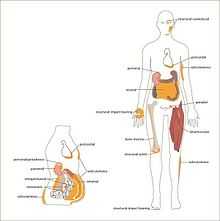White adipose tissue
| White adipose tissue | |
|---|---|
| Details | |
| Latin | textus adiposus albus |
| Identifiers | |
| Code | TH H2.00.04.0.0002 |
| Anatomical terminology | |

White adipose tissue (WAT) or white fat is one of the two types of adipose tissue found in mammals. The other kind of adipose tissue is brown adipose tissue.
In healthy, non-overweight humans, white adipose tissue composes as much as 20% of the body weight in men and 25% of the body weight in women. Its cells contain a single large fat droplet, which forces the nucleus to be squeezed into a thin rim at the periphery. They have receptors for insulin, growth hormones, norepinephrine, and glucocorticoids.
White adipose tissue is used as a store of energy. Upon release of insulin from the pancreas, white adipose cells' insulin receptors cause a dephosphorylation cascade that lead to the inactivation of hormone-sensitive lipase. It was previously thought that upon release of glucagon from the pancreas, glucagon receptors cause a phosphorylation cascade that activates hormone-sensitive lipase, causing the breakdown of the stored fat to fatty acids, which are exported into the blood and bound to albumin, and glycerol, which is exported into the blood freely. There is actually no evidence at present that glucagon has any effect on white adipose tissue.[1] Glucagon is now thought to act exclusively on the liver to trigger glycogenolysis and gluconeogenesis.[2] The trigger for this process in white adipose tissue is instead now thought to be adrenocorticotropic hormone (ACTH), adrenaline and noradrenaline. Fatty acids are taken up by muscle and cardiac tissue as a fuel source, and glycerol is taken up by the liver for gluconeogenesis.
White adipose tissue also acts as a thermal insulator, helping to maintain body temperature.
The hormone leptin is primarily manufactured in the adipocytes of white adipose tissue.
References
- ↑ Gravholt, C H. "Physiological levels of glucagon do not influence lipolysis in abdominal adipose tissue as assessed by microdialysis".
- ↑ Lawrence, A. M. (1969). "Glucagon". Annual Review of Medicine 20: 207–222. doi:10.1146/annurev.me.20.020169.001231. PMID 4893399.
| ||||||||||||||||||||||||||||||||||||||||||||||||||||||||||||||||||||||||||||||||